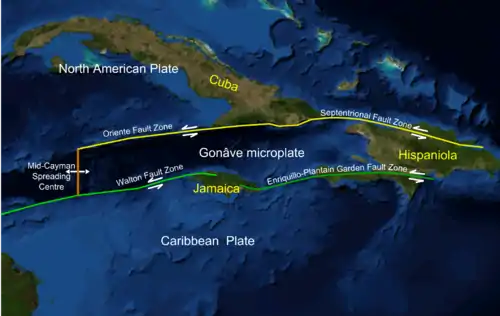Enriquillo–Plantain Garden fault zone
The Enriquillo–Plantain Garden fault zone (EPGFZ or EPGZ) is a system of active coaxial left lateral-moving strike slip faults which runs along the southern side of the island of Hispaniola, where Haiti and the Dominican Republic are located.[1] The EPGFZ is named for Lake Enriquillo in the Dominican Republic where the fault zone emerges, and extends across the southern portion of Hispaniola through the Caribbean to the region of the Plantain Garden River in Jamaica.

Geology
The EPGFZ shares approximately half of the relative motion between the North American and Caribbean tectonic plates with the Septentrional-Oriente fault zone which runs along the northern side of Hispaniola. Both faults merge into the Cayman Trench to the west. The fault accommodates about 20.6±1.66 millimeters of lateral motion per year (mm/yr).[2] Additionally, a component of compression is present as the North American Plate pushes toward the southwest. This results in vertical deformation manifest in the mountainous terrain of Hispaniola. Some researchers believe that the EPGFZ and the Septentrional-Orient fault zone bound a microplate, dubbed the Gonâve Microplate, a 190,000 km2 (73,000 sq mi) area of the northern Caribbean Plate that is in the process of shearing off the Caribbean Plate and accreting to the North America Plate.[3]
Earthquakes

- A magnitude 7.5 earthquake struck southeastern coast of Jamaica in 1692, almost destroying Port Royal
- An earthquake struck along the southern coast of Hispaniola in 1751.[4]
- A magnitude 7.5 earthquake struck Port-au-Prince in 1770.
- The 1907 Kingston earthquake damaged every building in Kingston, Jamaica.[1]
- A magnitude 7.0 earthquake occurred near Port-au-Prince, Haiti as a result of seismic activity along blind thrust faults associated with this fault zone on January 12, 2010.[5][6]
Other historical large earthquakes in 1860, 1761, 1684, 1673, and 1618 are also likely attributed to the EPGFZ, though none of these have been confirmed in the field as associated with this fault.[7]
Monitoring
A temporary Canadian seismic sensor network of three stations has been established in Haiti along the fault, as of February 19, 2010. The network is not considered permanent, but will remain for quite some time. The stations are in secure locations, being expensive equipment, and are satellite linked to Natural Resources Canada in Ottawa. They are solar powered, so do not require grid connections. One station is at the Canadian Embassy in Port-au-Prince (in the suburb of Pétion-Ville, in the district of Juvénat), and has a permanent guard of one. Another is at the Jacmel Airport, currently run by Canadian Forces personnel. The third is at a Léogâne orphanage, considered secure, but there are problems discouraging children from playing with it. The stations are roughly 50 km apart. These are the first seismic stations ever in the country.[8][9]
References
- Mann, Paul; Calais, Eric; Demets, Chuck; Prentice, Carol S. & Wiggins-Grandison, Margaret (March 2008). "Entiquillo-Plantain Garden Strike-Slip Fault Zone: A Major Seismic Hazard Affecting Dominican Republic, Haiti and Jamaica". 18th Caribbean Geological Conference. Archived from the original on 2010-01-16.
- Dolan & Mann 1998, p. 70
- Dolan & Mann 1998, p. ix
- Chen, Wai-Fah; Scawthorn, Charles (2003). Earthquake engineering handbook: New directions in civil engineering (1st ed.). CRC Press. pp. 4–44. ISBN 978-0849300684.
- Kluger, Jeffrey (January 13, 2010). "Could the Haiti Earthquake Have Been Predicted". Time. CNN. Retrieved January 20, 2010.
- Hayes, G.P.; Briggs, R.W.; Sladen, A.; Fielding, E.J.; Prentice, C.; Hudnut, K.; Mann, P.; Taylor, F.W.; Crone, A.J.; Gold, R.; Ito, T.; Simons, M. (2010). "Complex rupture during the 12 January 2010 Haiti earthquake" (PDF). Nature Geoscience. 3 (11): 800–805. Bibcode:2010NatGe...3..800H. doi:10.1038/ngeo977.
- "Poster of the Haiti Earthquake of 12 January 2010 - Magnitude 7.0". United States Geological Survey. January 15, 2010. Retrieved January 16, 2010.
- MUNRO, Margaret, ed. (19 February 2010). "Canadian seismic network monitors Haiti's turbulent underground". Vancouver Sun. Retrieved 22 February 2010.
- Radio Kiskeya, "La terre n’a pas fini de trembler en Haïti", 22 February 2010 (accessed 23 February 2010)
- Bibliography
- Dolan, James F; Mann, Paul (1998), Active Strike-slip and Collisional Tectonics of the Northern Caribbean Plate Boundary Zone, Special Paper 326, Geological Society of America, ISBN 978-0-8137-2326-6